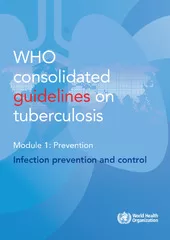TB infection prevention and control should be an integral part of national TB programmes and embedded within the measures taken at all levels in the country to prevent the transmission of infectious conditions. The new operational handbook will facilitate country adaptation and implementation of TB infection prevention and control measures. It emphasizes the importance of building integrated, well-coordinated, multisectoral actions across all levels of health care and other settings having high risk of TB transmission.
The handbook includes best practices from countries and provides checklists and job aids to support the implementation and monitoring of actions for administrative, environmental, and respiratory protection measures. Apart from health facilities, these measures may also apply to congregate settings having a high risk of TB transmission, such as prisons, refugee camps and homes for the elderly.
WHO calls upon governments to allocate the human and financial resources needed to strengthen the implementation of infection prevention and control. Collaboration between the Ministry of Health and other public and private authorities is necessary for the systematic implementation of TB infection prevention and control measures. WHO promotes the implementation of a hierarchy of interventions across all settings as an integrated package rather than standalone implementation of individual recommendations.
“Investment in preventive action, like TB infection prevention and control, will help to cut the chain of transmission not only in health care facilities, congregate settings, or workplaces but also the households of people with TB”, said Dr Tereza Kasaeva, Director of the WHO’s Global TB Programme. “This is vitally important in our collective fight to end TB”.











